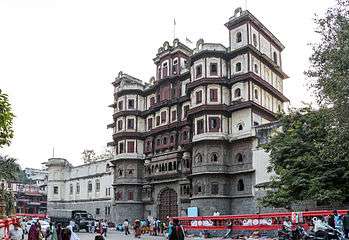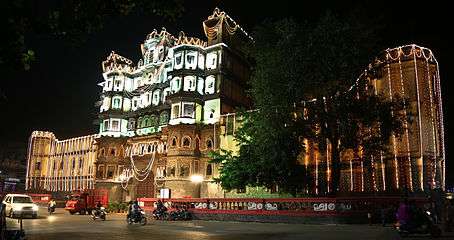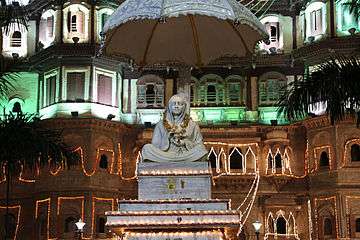Rajwada
| Rajwada | |
|---|---|
|
राजवाडा राजबाड़ा | |
 Rajwada Palace, Indore | |
| General information | |
| Type | Maratha and Mughal style City Palace |
| Architectural style | Indo-Saracenic Maratha |
| Location | Indore, India |
| Elevation | 553 m (1,814 ft) |
| Current tenants | The Khasgi Ahilyabai Holkar Charities Trust |
| Completed | 1766 by Holkars |
| Renovated | March 2007 By H.H Ushadevi Holkar |
| Destroyed | 1984 by Fire in Riots |
| Client | Holkars |
| Owner | M.P State Archaeology Grade A Monument |
Rajwada (Hindi: राजवाडा) is a historical palace in Indore city. It was built by the Holkars of the Maratha Empire about two centuries ago. This seven storied structure is located near the Chhatris and serves today as a fine example of royal grandeur and architectural skills.[1]
Structure
The structure comprises two parts, the first one located at the heart of the city and the second one standing in the old part of the town. Rajwada palace exhibits a blend of Maratha styles, the palatial structure is sure to leave you spellbound. The entrance itself is beautiful with lofty archway and a giant wooden door covered with iron studs. As one makes his way through the entrance, one is greeted with a courtyard comprising Maratha arched Ganesha hall, a number of balconies with Maratha ornamentation, windows, and corridors, surrounded by galleried rooms. The lower three floors are made of stone and the upper floors are made of wood.
The existing building is rectangular with cylindrical bastions at the four corners. It was constructed in 1766 and later the southern part was rebuilt in the years 1811-1833 after being damaged by fire. The Palace was constructed by the Muslim artisans from Mandu who worked for the Marathas but sought refuge in Malwa with their families, At that time only the Muslims were the most skilled crafts persons. These families lived in and around Indore and went on to work for several structures for the Holkars. Today it stands proudly with its 7 story façade of carved stone and wood jails, jharokhas and chattries. The front bay has substantial forecourt assessed by a large fenestration in the front façade. All activity within this structure has been systematically removed and now boasts of a small office of the Joint Director, Archeology and Souvenir Shop run by the Archeology. The rest of the building is ground and two floors. One side of the front bay has been destroyed as has the complete rear bay. The rear bay, before reconstruction was an empty shell with garden within, enveloped by the thick external wall with the bastions. The architecture is of the Maratha period & style. Planned with courtyards suited to tropical climes the Maratha architecture is known for its simplicity, visible visual logic & austere aesthetic, made rich by beautiful detailing, rhythm & repetition. The aisles & arcades, punctured by delicate niches, doors & windows create a space in which articulation of open, semi-open & covered areas is effortless and enchanting. The Rajwada is now state property under the Archeology who granted special permission for rebuilding the old wada (residence) which was the main Rajwada which was completely burnt during the 1984 riots, namely the building around the Tulsi Kund along with the temple that previously existed there, between the two rear courtyards. This building was to be rebuilt by H.H Usha Raje Holkar and designed by architects Himanshu Dudwadkar and Shreya Bhargava on the 200-year-old blue print using the same material & finishes, while adhering to the seismic structural requirements, mandatory today. The rebuilding was to be identical to what existed earlier – constructed with thin bricks in lime mortar with lime plaster, with wooden columns with stone bases, rough black basalt flooring & a brick paved courtyard in tandem with the age-old building techniques. The only departure from the original building was a concealed ms pipe frame for structural stability in this earthquake prone zone - a necessity to obtain relevant building permissions.[2]
Images
- Image Gallery
 Rajwada Palace as seen on Diwali 2014
Rajwada Palace as seen on Diwali 2014 Ahilyabai Holkar Statue in front of Rajwada
Ahilyabai Holkar Statue in front of Rajwada Rajwada Palace as seen in the day
Rajwada Palace as seen in the day
See also
- Yeshwant Club, Indore
- New Palace, Kolhapur of the Bhonsle Chhatrapatis
- Laxmi Vilas Palace, Vadodara of the Gaekwads
- Jai Vilas Palace, Gwalior of the Scindias
- Shaniwar Wada, Pune of the Peshwas
- Thanjavur Maratha palace of the Bhonsles
References
- ↑ "Rajwada Indore". Tour Travelworld. 2010-03-23. Retrieved 2010-03-23.
- ↑ "Rajbada in Indore". Indore Administration. 2010-03-23. Retrieved 2010-03-23.
External links
Coordinates: 22°43′06″N 75°51′19″E / 22.7184°N 75.8552°E